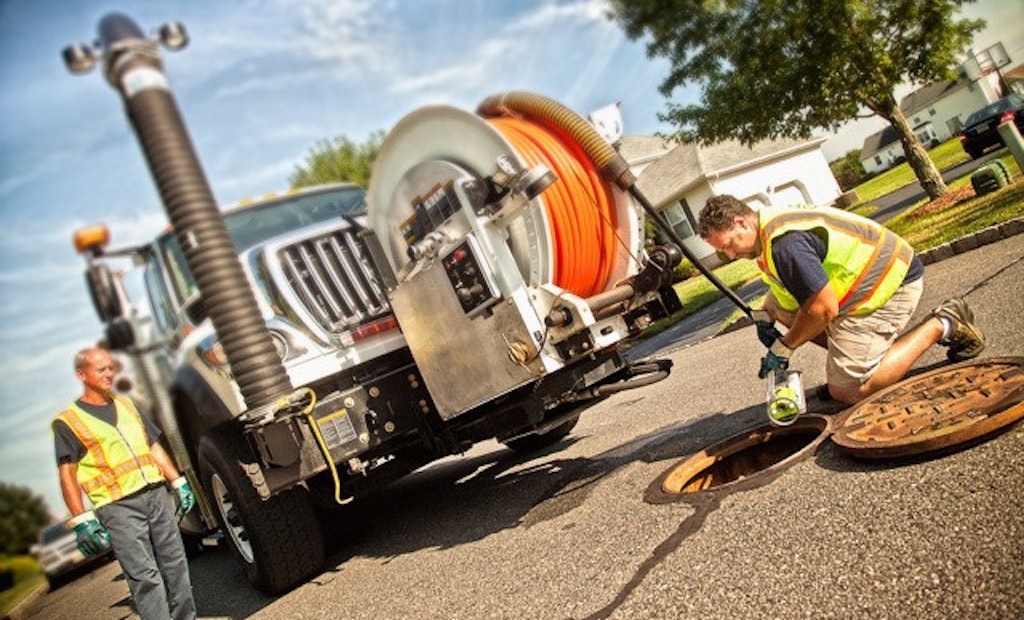Interested in Inspection?
Get Inspection articles, news and videos right in your inbox! Sign up now.
Inspection + Get AlertsDespite the power of jetting, operators have historically had to work blind. They’re given little if any information about the cleaning challenges underground. And often, the only visual indication of cleaning success involves watching effluent in a downstream manhole until it runs clear.
Pre- and post-cleaning visual inspections can be performed by a CCTV crew but the extra expense and manpower seldom makes this option viable on a large scale. More commonly, jetting is performed with no visual feedback and CCTV inspection is undertaken only after repeated callbacks prompt further investigation.
An attempt to solve this problem first emerged 15 years ago, with the introduction of the “jet camera” — a camera attached to a jetter nozzle. A jet camera offers a quick, independent way to assess cleaning challenges: sediment, debris, FOG, collapses, protruding taps and root balls. With this information, an operator can select the most suitable nozzle, water pressure and cleaning speed. Beyond that, he can confirm afterward that cleaning was successful, and even alert higher-ups to observed structural problems requiring further attention.
Although the benefits of seeing what you’re jetting are obvious, there are technological and budgetary considerations when choosing a camera that warrant closer scrutiny. Most have to do with early challenges jet camera technology presented and how subsequent product innovation overcame them. This evolution has resulted in two distinct species of product:
- Jet camera: A hard-wired nozzle camera that transmits SD video back to the operator in real time.
- Video nozzle: A self-contained, cable-free nozzle camera that records HD video to onboard digital media to be viewed after jetting.
So what do these distinctions mean in the real world?
.jpeg) Real Time vs. Uptime. Real-time video from inside a sewer pipe requires a hard-wired connection, and jet cameras use electrical conductors (either external wires, or conductors fabricated into the hose) to transmit video. The violence of the application — high-pressure water, projectile debris, continuous flexing — places enormous strain on these conductors, frequently resulting in failure and costly repair. It also adds to the complexity of the equipment, with external conductors requiring a separate cable reel running synchronously with the jetter’s hose reel. Vulnerable connections have been a primary factor inhibiting the widespread acceptance of jet camera technology.
Real Time vs. Uptime. Real-time video from inside a sewer pipe requires a hard-wired connection, and jet cameras use electrical conductors (either external wires, or conductors fabricated into the hose) to transmit video. The violence of the application — high-pressure water, projectile debris, continuous flexing — places enormous strain on these conductors, frequently resulting in failure and costly repair. It also adds to the complexity of the equipment, with external conductors requiring a separate cable reel running synchronously with the jetter’s hose reel. Vulnerable connections have been a primary factor inhibiting the widespread acceptance of jet camera technology.
Eliminating external conductors improves uptime and lowers cost of ownership of video nozzles like Envirosight’s Jetscan. This is achieved by digitally recording video for viewing immediately after jetting, rather than in real time. This paradigm arose from manufacturers realizing that most cleaning challenges can be identified with intel from a pre-cleaning pass — and that for cleaning crews, where the productivity of expensive equipment and multiple personnel hang in the balance, reliability and uptime are paramount.
Detail. HD video can deliver up to 6.75 times the resolution of SD video. This makes HD video vastly preferred for characterizing defects and obstructions, and for discerning side-wall detail at typical nozzle speeds. HD video is only available with a video nozzle, primarily because transmitting HD video requires many more conductors than SD.
Cost. The average cost of a jet camera is approximately double the cost of video nozzles. This makes video nozzles far more accessible, allowing cities to easily implement jetting video on a fleetwide basis, rather than simply as a specialty.
Beyond purchase price, the lack of external conductors makes video nozzles extremely reliable, resulting in a comparatively minimal cost of ownership.
Compatibility. Video nozzles are plug-and-play, requiring no external support apparatus during operation. For that reason, they attach in seconds to any standard jetter hose, with no modifications to the truck itself. This makes video nozzles easy to share among trucks. Similarly, captured video can be viewed and shared among departments using any touch-screen tablet device with a Wi-Fi or wireless broadband connection.
Regardless of the differences between a jet camera and a video nozzle, either approach is far superior to jetting blind. Not only does video footage make jetting safer and more effective, it provides valuable visual information that can be used upstream to plan CCTV, maintenance and rehab activities. With the costs of jetting blind so high — in terms of dollars, personnel hours, gallons of water, and liability — every cleaning crew deserves to be jetting with vision.
Visit Jetting with Vision to read the complete white paper. Click here to learn more about the Jetscan video nozzle and to schedule an on-site demo.






